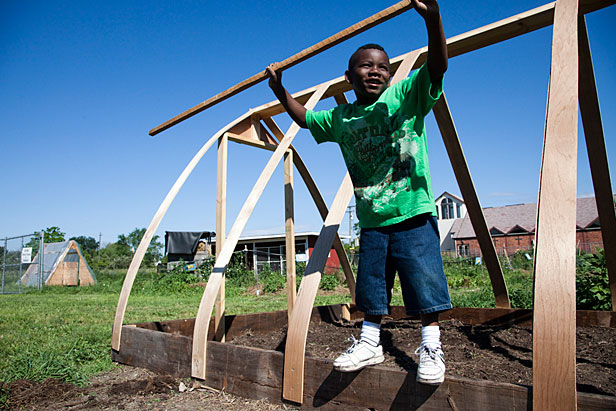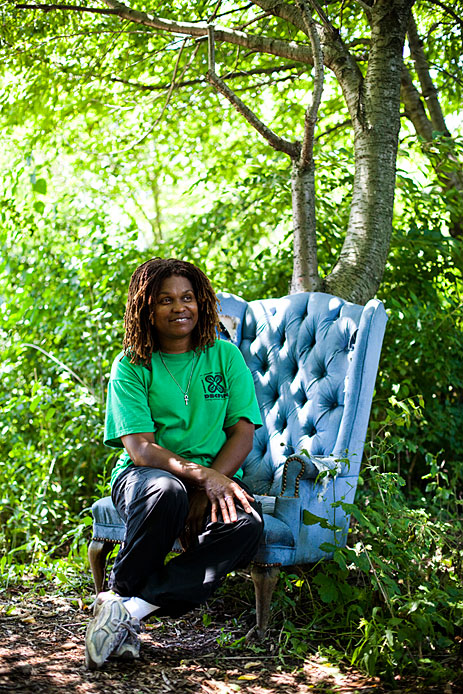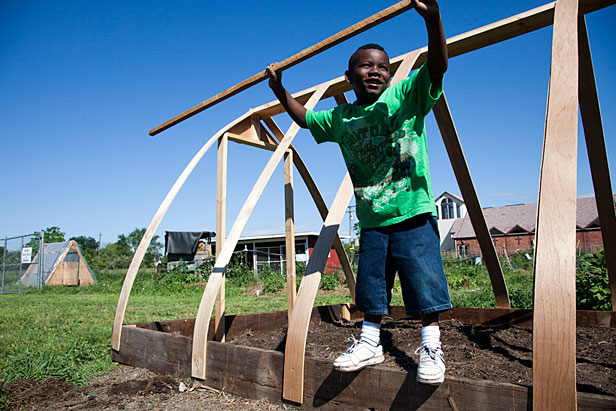
(Photos ©Michael Hanson)
Avram Rodgers, 6, says he and I are secret agents. He takes my hand and pulls me to the rabbit pens in the back of a fenced-in, grassy area at the Catherine Ferguson Academy farm in Detroit. A handful of ducks waddle in a little pool in the center of the enclosure. Goats chew grass in their separate pen 30 feet away, and a group of young women students build a small greenhouse 50 feet away.
Avram points out an eviscerated rabbit in the thick grass and informs me that we must find its killer. The young bunny likely escaped its cage, and my hunch is hawk or raccoon. Avram is less certain. But we investigate the crime scene for only another 30 seconds until Avram’s imagination takes a turn, and we veer out of the duck and rabbit area and toward the greenhouse.
We don’t find the culprit, but Avram has just revealed something far more interesting. His backyard mystery personifies the collision of raw life/death and wide-open imagination that has come to define Detroit in a much deeper way than the job-loss headlines and banal images of windowless buildings that have become far too popular in European art magazines.
Avram is a city kid, but he walks around here like a country kid. He basically grew up on this urban produce and livestock farm that takes up roughly half of the school lot for the Catherine Ferguson Academy. CFA is a Detroit public school for teenage mothers; Avram’s mom, Ashley Rodgers, entered in ninth grade after becoming pregnant with Avram.
Ashley, now 21, leads the crew of students as they wrap the small greenhouse in plastic. The group of girls will travel to South Africa at the end of July for an international youth conference on food security and farming. They’ll teach a workshop in greenhouse construction, among other things. Crazy thing is, it’s not so crazy that inner-city Detroit youth will be teaching farming to the world.
Everyone knows about the economic woes of Detroit. The city’s unemployment and foreclosure rates lead the nation. It has become the national emblem of industrial failure, just as Wall Street has become the symbol for soft, pasty, and greedy semi-men. But Wayne County and Detroit have been somewhat of a void — a gritty blank slate for decades, traced back to the race riots of the ’40s and ’60s. The population peaked around 2 million in 1950 and now hovers at 850,000. The exodus has left an estimated 17,000 acres of vacant lots.
There’s an odd undercurrent of tension amongst some of these groups. It’s a little bit Lord of the Flies out here in this wilderness of vacancy.
While the rest of the cities we’ve seen throughout this trip have their share of unused land, Detroit’s sea of potential has created a sense of Manifest Destiny among the urban farm pioneers. Just like artists who can experiment at the fringe of their crafts when they move into huge, unwanted warehouse spaces in empty downtowns, Detroit farmers are at the cutting edge of urban agriculture.

Marilyn Nefer Ra Barber, head of D Town farm
Wild Wild Wayne
In the course of our three days in Detroit, we weave through a fraction of the network of projects and organizations. We see D Town, a two-acre model farm begun at west Detroit’s Rouge Park. They grow vegetables and mushrooms, raise bees, and sell honey at a few of the city’s markets, specifically Eastern Market, the 120-year-old outdoor farmers market in downtown.
We see some projects associated with The Greening of Detroit, an expansive organization begun in 1989 with, initially, a mission to re-tree Detroit in response to a half-decade of massive tree loss (500,000 lost between 1950 and 1980). The Greening now has its hands in hundreds of community gardens and small plots throughout the city, in addition to the large tree-planting projects like the 105 acres they just bought at Rouge Park adjacent to D Town. Marilyn Nefer Ra Barber (right) runs D Town farm. A native of South Carolina, of Gullah-Geechee descent, she talks of how the agriculturalists who moved to Detroit from the South — partly to replace the unjust farm life with promising factory jobs — are now returning to the land in their backyards and neighborhoods. “Before, we had all the jobs and the money and we could buy what we needed. Now we can plant a seed and have control through our food,” she says.
We visit the Capuchin Soup Kitchen’s Earthworks Farm where a group of neighborhood youth tend to a garden and sell the produce at the markets. Earthworks also aids neighborhood residents with their own backyard food gardens, working on a hyper-local scale.
Urban Farm, Incorporated?
Finally, we speak with Mike Scroll, president of Hantz Farms, the massive, multi-million-dollar urban farm project that could become the largest urban growing initiative in the country. Mike says that Hantz now has three projects in the works, comprising three acres, five acres, and a hundred-plus. He said they plan to grow hardwoods, Christmas trees, fruit and nut trees, and hydroponic and aeroponic vegetables. He said they’ll stay away from the existing markets so as not to impede on the current growers’ market share. But that means they’ll be shipping all over the country rather than feeding Detroit.
Mike was a nice man, and his ambitious project sounds potentially great as far as developing a profitable model for urban farming on a large scale and for job creation in Detroit. But they’re getting somewhat beat up in the press by the smaller grassroots projects who’ve been doing this for decades. Mike says that while the public voice sounds critical, in private, these same urban farm organizations are asking to partner with Hantz via employment opportunities for the organizations’ trainees and interns.
I must say, there’s an odd undercurrent of tension amongst some of these groups. It’s a little bit Lord of the Flies out here in this wilderness of vacancy.
Back to the barn
After so much running around, we find our safe place back at Catherine Ferguson Academy’s farm. This one’s been operating under the radar and out of the fray for 20 years. It did not begin with a mission to save the city or to be a model for the world. It began because Paul Weertz, the science teacher, did not want his students — teenage mothers and mothers-to-be — to inhale formaldehyde during dissections. So Paul, now 56, began keeping a couple live rabbits and chickens in pens out back so he could practice “fresh dissections” without the need for toxic preservatives. Soon he had more chickens and rabbits and a few goats. Within years, they plowed over the playground soil, planted food, and the students helped him build a barn.
Weertz spends about half his classtime in the classroom and half at the farm, overseeing the students as they milk the goats, feed the chickens or the horse, or water and weed and seed the vegetable plots. They seed, collect, and bale hay from 10 acres of vacant city lots and store it in the barn.
And they love it, says Weertz:
“The farm is a great way to teach parenting skills,” he says. “If you don’t water and feed the plants, they wither up and die. Milking the goats is the same as breast-feeding. And training the goats, too. We teach kids how training works — you gotta be smarter than the animal. I let the goats run wild for the first milking and then I teach the girls that you have to outthink them and train them to do what you want them to do.”
Watch the students milk a goat and ask questions:
A while ago I read an article in Atlantic Monthly titled “Cultivating Failure.” Writer Caitlin Flanagan argued that the en vogue school farms act as a distraction from the book-learning that must occur to get our underserved students into college (and a higher economic strata). While I could dismiss the author’s palpable, almost personal distaste for all things Alice Waters, the critique of school farms as a wasteful, feel-good hobby fad of yuppie educators has been bothering me for months.
“If I said to a farm kid, ‘You don’t need computers, you just need to know farm equipment,’ that’d be discriminating. You can’t do the inverse with the city kids and tell them all they need to know is on a computer.”
Paul gets that occasionally as well, even in Detroit where growing your own food is becoming a powerful symbol of autonomy. “Some people say I just have them out there working on the farm, but I think they’re getting smarter. Many kids are just not moving (these days) and scientists are learning that we’re pretty smart when we use our hands. I think when we’re out there working with our hands we’re recharging our brains.
“If I said to a farm kid, ‘You don’t need computers, you just need to know farm equipment,’ that’d be discriminating. You can’t do the inverse with the city kids and tell them all they need to know is on a computer.”
Sure, the way testing is currently set up relies heavily on classroom skills, but the farm, via feeding schedules, planting plans, chicken coop measurements, puts those skills to real tests. Paul knows he and CFA have a unique situation working with a population of students largely rejected from the mainstream. They’re in the system, but at the fringe, sort of how Detroit is in the national sense. Only now people are starting to watch Detroit. The mayor’s talking about consolidating neighborhoods and big capital is moving in via Hantz. CFA is old-school in that they still operate and create in their own gap, that edge space of reality and imagination.
Detroit has a glut of space. That can be a blessing and a curse, even among the most well-meaning organizations. Seeing the city as a study in the growth and interaction of grassroots organizations could be as informative as viewing it as a test in the growth of food and jobs.
It’s an experiment and a bust and a success and an opportunity and the reason people are watching is that it’s as real and visceral as a dissection.
All content ©Breaking Through Concrete, adapted with permission. For information regarding use of images, video, or text, please contact btctour@mail.com.



